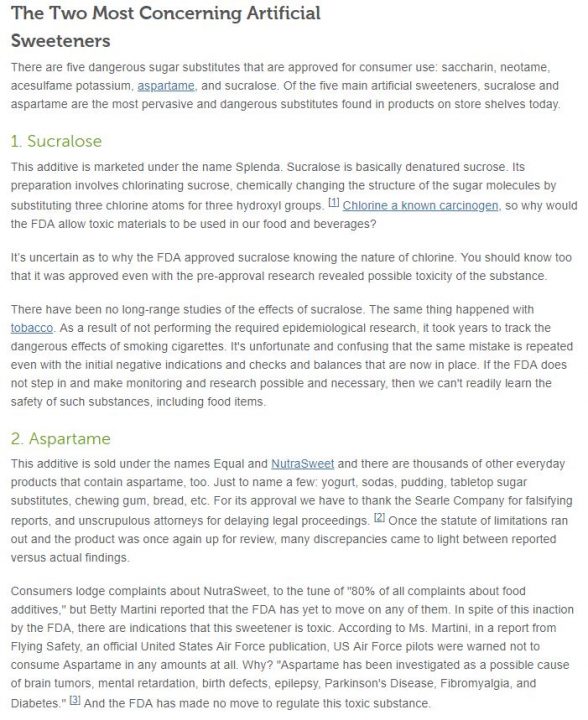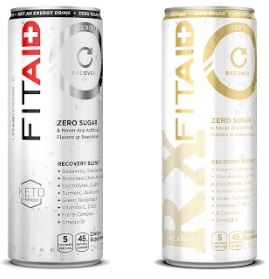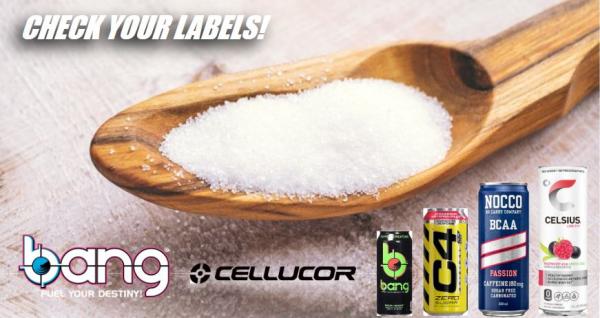If you consume products that contain Sucralose, please be warned of its various negative health effects!
Common side effects of Sucralose & Splenda consumption include: + Gastrointestinal problems (Sucralose can destroy as much as 50 percent of the microbiome in your gut) + Seizures, dizziness, and migraines + Heart palpitations or fluttering + Blurred vision & allergic reactions + Blood sugar increases, weight gain and Type 2 diabetes *Read the entire article and findings below.Original article by Dr. Mercola, author of Sugar Substitutes—What's Safe and What's Not | Published on December 18, 2013
STORY AT-A-GLANCE
- An in-depth scientific review of sucralose (Splenda) reveals an extensive list of safety concerns, including toxicity, DNA damage, and heightened carcinogenic potential when used in cooking.
- When heated, it releases chloropropanols, which belong to a class of toxins known as dioxins. Dioxin—a component of Agent Orange—is among the most dangerous chemicals known to man!
- Sucralose can destroy as much as 50 percent of the microbiome in your gut. What’s worse, it appears to target beneficial microorganisms to a greater extent than pathogenic and other more detrimental bacteria.
- Both animal and human studies have shown that Splenda alters glucose and glucagon-like peptide-1 (GLP-1) levels, thereby promoting weight gain and type 2 diabetes.
- The adverse effects of sucralose are oftentimes misdiagnosed or overlooked entirely as the side effects are so varied and mimic common ailments.
- Gastrointestinal problems
- Seizures, dizziness, and migraines
- Blurred vision
- Allergic reactions
- Blood sugar increases and weight gain
Sucralose—NOT Safe for Cooking After All
The featured report came to several important conclusions—all of which challenge the "generally recognized as safe" (GRAS) status of sucralose. Of primary concern is that sucralose is not an inert substance. When heated, it releases chloropropanols, which belong to a class of toxins known as dioxins. One of the selling points of Splenda is that it remains stable when heated, making it well-suited for cooking and baking, but these findings refute such claims. (Many other artificial sweeteners, such as aspartame, are not recommended for cooking purposes as they're known to break down in high temperatures.) As reported by Sayer Ji at GreenMedInfo.com,4 research now shows that sucralose starts breaking down at 119 degrees Celsius; 180 degrees Celsius causes it to degrade completely. Dioxin is a waste product of incineration, smelting, chlorine bleaching, and pesticide manufacturing, and its well-documented health effects include cancer and endocrine disruption. In fact, dioxin, which was a toxic component of the Agent Orange used to defoliate jungles during the Vietnam War, is easily one of the most dangerous chemicals known to man. Another study5 published in October also expressed concern over the chlorination reactions that occur when sucralose is cooked in stainless steel cookware, generating highly toxic compounds, including dioxins6 and polychlorinated dibenzofurans (PCDFs). Recent animal research also suggests a link between Splenda consumption and an increased risk of leukemia.7 Based on such research, the time is more than ripe for the US Food and Drug Administration (FDA) to reconsider the GRAS status of sucralose...Sucralose Also Destroys Your Gut Health
The featured review also concluded that sucralose destroys gut bacteria. (In fact, animal research8 published in 2008 found it could kill as much as 50 percent of your microbiome.) This is very important, as anytime you destroy healthy intestinal bacteria, you open yourself up to unfriendly micro-organisms that can cause health problems. Your immune system, which is imperative for general health, is dependent on healthy gut flora, so the idea that this artificial sweetener may destroy up to half of all your healthy gut bacteria is disconcerting to say the least. Worse yet, sucralose appears to target beneficial microorganisms to a greater extent than pathogenic and other more detrimental bacteria. And remarkably, according to one study, these adverse effects on gut microbiota remained even after a three-month long recovery period... Early studies, upon which its approval was based, claimed that sucralose would simply pass unchanged through the human gastrointestinal tract, but more recent investigations show that it is indeed metabolized in your gut. And, as reported in the featured review, "the identity and safety profile of these putative sucralose metabolites are not known at this time."Diabetics Beware...
The third issue is of particular importance for diabetics, who tend to use artificial sweeteners to manage their condition.9 Alas, both animal and human studies showed sucralose alters glucose and glucagon-like peptide-1 (GLP-1) levels. A related study published in the journal Diabetes Care10 in September came to a virtually identical conclusion. Compared to the control group, obese patients using sucralose experienced a greater incremental increase in peak plasma concentrations, a greater incremental increase and peak secretion rate ... According to the authors:"These data demonstrate that sucralose affects the glycemic responses to an oral glucose load in obese people who do not normally consume non-nutritive sweeteners."
Toxicological Issues Still Need to Be Addressed
According to the featured review, there are "numerous toxicological issues regarding long-term exposure to sucralose" that remain "unresolved." This includes:- Genotoxicity (DNA damage) and potentially adverse epigenetic effects
- The generation of toxic compounds when heated
- Bioaccumulation (One 2009 study found unmistakable evidence that Splenda is absorbed by body fat, contrary to previous claims)
- Potential drug interactions
I might also add that these two studies consisted of a combined total of 36 people, of which only 23 people actually ingested sucralose, and the four-day trial looked at sucralose in relation to tooth decay, not human tolerance! Sadly, if you're a long-term Splenda user, you're actually acting as a human guinea pig, as no one knows what happens when humans consume this substance for long periods. If you look through the research literature, you'll find that only about 10 percent of the studies involving sucralose have anything at all to do with safety. In fact, eight years ago when I wrote the book Sweet Deception, in which I expose the many concerns related to the consumption of artificial sweeteners, there were only 15 studies relating to the safety of sucralose, and 13 of them were funded by the company that makes Splenda, leaving enormous room for conflict of interest."Sucralose is classified by the FDA as safe for human consumption as a food additive. The FDA stated that their decision was based upon results from 110 animal and human studies of the effects of sucralose. Of the 110 studies, two were on human beings, with one being a four day trial by the manufacturer,"The Examiner reports. [Emphasis mine]
Industry Funded Studies FAR More Prone to Miss Safety Concerns
If you believe a company can be trusted to perform independent safety studies for their own products, consider the following example. In 1996, Dr. Ralph G. Walton reviewed 165 studies on the widely used artificial sweetener aspartame, discovering a remarkable discrepancy between study results and their source of funding. Of the 165 studies, 74 had industry related funding and 91 were independently funded. Of those:- 100 percent of the industry funded studies supported aspartame's safety, while
- 92 percent of the independently funded studies identified at least one potential health concern
Prevalence and Diagnosis of Sucralose Sensitivity
Unfortunately, the adverse effects of sucralose are oftentimes misdiagnosed or overlooked entirely as the side effects are so varied and mimic common ailments. The following are common symptoms, usually noticed within a 24-hour period following consumption of a Splenda product:| Skin -- Redness, itching, swelling, blistering, weeping, crusting, rash, eruptions, or hives (itchy bumps or welts) | Lungs -- Wheezing, tightness, cough, or shortness of breath | Head -- Swelling of the face, eyelids, lips, tongue, or throat; headaches and migraines (severe headaches) |
| Nose -- Stuffy nose, runny nose (clear, thin discharge), sneezing | Eyes -- Red (bloodshot), itchy, swollen, or watery | Stomach -- Bloating, gas, pain, nausea, vomiting, diarrhea, or bloody diarrhea |
| Heart -- Palpitations or fluttering | Joints -- Joint pains or aches | Neurological -- Anxiety, dizziness, spaced-out sensation, depression |
Splenda Is Not a Safe and Healthy Alternative to Sugar
Splenda is made from sugar, but chemically it's more similar to DDT. Mounting research shows there's a veritable laundry list of health concerns associated with it, from destroying your gut health to promoting diabetes and cancer. Truly, you're consuming it at your own risk, as FDA approval is NOT a guarantee of safety... As stated by Sayer Ji:18My strong suggestion is to avoid ALL artificial sweeteners like the plague. While the mechanisms of harm may differ, they're all harmful in one way or another. This includes"Chlorinated compounds like dioxins and DDT are notorious for being both highly toxic and resistant to breaking down once released into the environment, which is why they are classified as 'persistent organic pollutants.'Splenda was launched in 2000 with tagline 'Made from sugar, so it tastes like sugar,' until it retired this slogan in 2007 after settling with its rival, Merisant Co., the maker of Equal, who accused the makers of Splenda of intentionally confusing consumers into thinking its product was more natural and healthier than other artificial sweeteners. Long gone are the days that this artificial sweetener can be marketed as natural, safe and a healthy alternative to sugar."
Additional resource: Global Healing Center

WHAT’S IN YOUR CAN?
Check your label! These popular brands all make products containing Sucralose/Aspartame:
Bang® • C4® • Celsius® • Nocco®
WHAT'S IN FITAID CANS?
The new FITAID ZERO and FITAID RX ZERO are happily sweetened with natural Monk Fruit & Stevia. Our products and energy drinks are always made with ONLY THE GOOD STUFF. They contain NO Sucralose, NO Aspartame, NO artificial sweeteners, NO junk! Note: FITAID and FITAID RX are sweetened with just a pinch of natural sugar from raw organic agave.
Join our movement: #ABetterWayToDrink
ZERO is now availble at LIFEAIDBevCo.com/ZERO

> > > Live well.
